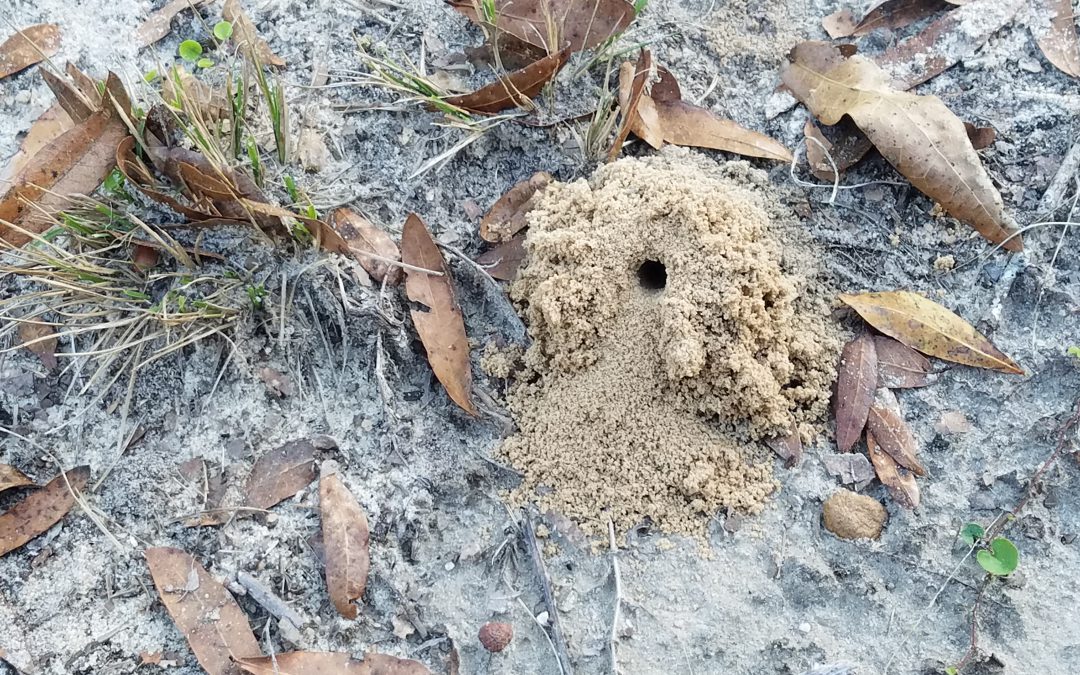
by Evan Anderson | May 20, 2021
Lawns and landscapes are greening up this time of year, and it’s not just plants showing signs of activity. All sorts of creatures are out there living their lives, and some of them are doing some digging.
From little piles of dirt to big mounds and long tunnels, it can be frustrating to figure out what is disrupting your carefully tended lawn or ornamental bed. Luckily, there are differences between the possible culprits. Here are some of the possibilities (see the associated links for more information and control methods):
-

A miner bee hole. Photo: Evan Anderson
Miner Bees (and other ground nesting bees and insects) – Miner bees are harmless, solitary bees that tunnel into the soil. Not to be mistaken for yellowjackets, each bee digs her own small nest to lay her eggs in. Multiple such bees may be attracted to the same location, but they do not form hives and aren’t aggressive. Small mounds of soil may form around the entrances to their nests, but these will vanish after a rain.
- Moles – Small mammals (not rodents) that produce raised tunnels along the surface of the ground. They forage for insects among the roots of plants, and while their presence does have some benefits, many homeowners dislike their aesthetic contributions to the landscape. If you can overlook their tunnels, they do help aerate soil and eat pests like mole crickets, grubs, ant larvae, caterpillars, and slugs.
- Pocket Gophers – Sometimes called “sandymounders” or “salamanders” by old-timers, these are small rodents that dig tunnels beneath the ground. Active especially in cooler months, they make a series of mounds of soil in a line along their tunnel as they excavate. They feed on roots, bulbs, and tubers, though their sand-mounding is often more a problem than their feeding.
-
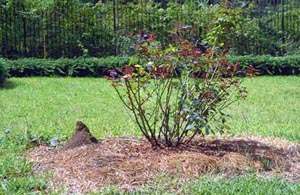
A fire ant mound in the landscape. Photo: B. Drees
Fire Ants – A single ant isn’t particularly threatening, but fire ants have found that thousands of rage-filled friends make a good deterrent. They build large mounds of soil to help regulate temperature and moisture in their nests, which can be quite unsightly in the landscape. Disturbing these mounds will unleash hordes of stinging ants, so beware; while they don’t necessarily do any harm to plants, they aren’t terribly friendly neighbors.
- Squirrels -These tree-dwelling rodents may nest up in the boughs, but often come down to the ground to look for food. In doing so, they may dig small holes as they forage for nuts, seeds, and fungi. The holes they dig are typically shallow and usually not too much of a problem.
- Armadillos – Nocturnal and heavily armored, the armadillo forages for insects in the ground. While it may sound beneficial to have an animal removing all the pest insects around, they aren’t careful about the damage they do while they feed. A hungry armadillo can dig numerous 3-5 inch wide, 1-3 inch deep holes in a lawn overnight, and may also burrow under structures, driveways, and patios.
- Yellowjackets – Yellowjackets are a bit of an honorable mention for this list, due to the fact that their digging often goes unseen. These ground-dwelling hornets leave no mounds or raised tunnels to identify their nests by. Instead, a small hole is often the only indication they are present, until a person or pet disturbs them. Then…surprise! It’s time for stinging, screaming, and crying.
For animal pests, the Florida Fish and Wildlife Conservation Commission maintains a list of nuisance wildlife trappers at https://public.myfwc.com/HGM/NWT/NWTSearch.aspx. For insects, you may need to contact a local pest control specialist or company. For help in identifying a problem, contact your local Extension office.
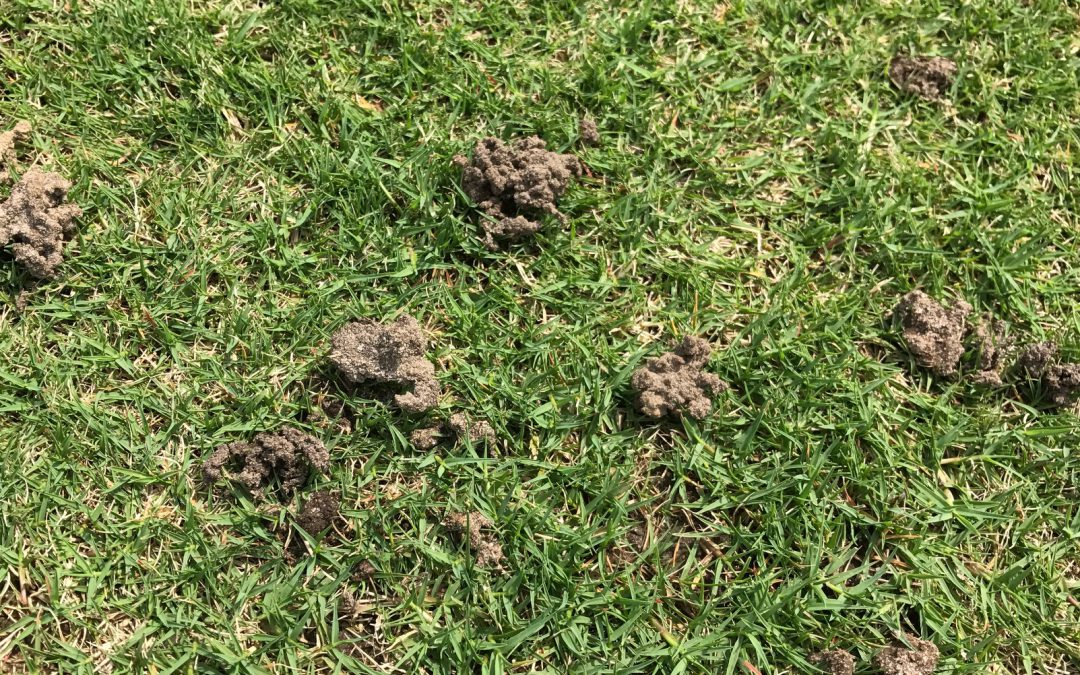
by Mary Salinas | Apr 15, 2021
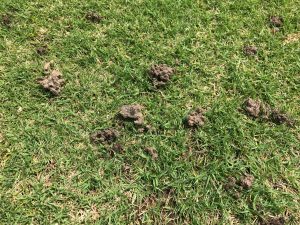
Worm mounds in bermudagrass. Photo credit Mary Salinas, UF IFAS Extension.
The April 8 program of Gardening in the Panhandle LIVE! was focused on turfgrass, quite a popular topic in the springtime as the weather warms and turf comes out of winter dormancy. Here are some of the questions asked of our University of Florida experts and the links to resources they shared.
To start with, two sites that have comprehensive information are Your Florida Lawn: http://hort.ufl.edu/yourfloridalawn/ and Gardening Solutions: https://gardeningsolutions.ifas.ufl.edu/
Turfgrass Selection
Q. What’s the answer to “I want a lawn like I had up north”? Remotely possible?
A. You can have a nice lawn, but it is going to be different in the panhandle. Don’t expect the same grass species or maintenance.
Q. What grass species is recommended for winter overseeding, and when should the grass be sown?
A. Overseeding has its problems and generally not recommended as it shades out the warm season turf as it is coming out of dormancy in the spring. Overseeding Florida Lawns for Winter Color: https://sfyl.ifas.ufl.edu/archive/hot_topics/lawn_and_garden/overseeding_winter_lawns.shtml
Q. How well do new turfgrass varieties thrive against weeds?
A. A healthy and properly maintained lawn is your best defense against weeds and other pests. Additionally, ProVista is a new cultivar of St Augustinegrass that can tolerate glyphosate so it makes it much easier to kill weeds in the lawn. ProVista is not yet widely available in the panhandle.
Q. How do I get a lawn started?
A. Preparing to Plant a Florida Lawn: https://edis.ifas.ufl.edu/lh012
Establishing a Florida Lawn: https://edis.ifas.ufl.edu/topic_lawn_establishment
Q. Can I have a native lawn? What are some recommended alternatives to a turf lawn?
A. Opinions are divided as to whether St. Augustinegrass is native. See these links for lawn Alternatives: https://gardeningsolutions.ifas.ufl.edu/lawns/turf-types/alternatives-to-turfgrass.html
https://gardeningsolutions.ifas.ufl.edu/mastergardener/webinars/mg-update-june2018/ffl-lawn-alternative-mg-update-june-2018-handout.pdf
Fertilizing & Weed Control
Q. How long should I wait before fertilizing new sod?
A. Wait 30-60 days before applying fertilizer. See: Homeowner Best Management Practices for the Home Lawn: https://edis.ifas.ufl.edu/ep236
Q. Basic fertilizer for most lawns if no other information is available.
A. 15-0-15
Q. Are weed and feed products effective? Can you use a Weed & Feed like Scott’s Bonus S this late in the year?
A. Weed and feed products are not recommended.
Weed & Feed, Not Foolproof: https://ocmga.wordpress.com/2013/03/11/weed-and-feed-not-foolproof-by-larry-williams-ufifas-extension-agent/
Weed Management Guide for Florida Lawns: https://edis.ifas.ufl.edu/ep141
Lawn Maintenance & Renovation
Q. My husband overwaters the lawn. Remind everyone about correct watering.
A. Homeowner Best Management Practices for the Home Lawn: https://edis.ifas.ufl.edu/ep236
Watering Your Florida Lawn: https://edis.ifas.ufl.edu/lh025
Sprinkler calibration: https://gardeningsolutions.ifas.ufl.edu/care/irrigation/calibrating-your-irrigation-system.html
Q. What to do about bare spots in St Augustine turf in shade?
A. Rough up the ground and put ½ to 1” compost and let the grass fill in or plant plugs. St. Augustinegrass for Florida Lawns: https://edis.ifas.ufl.edu/lh010
Q. When is the best time to overseed? I have a centipede lawn that’s 15-16 years old and I’m trying to bring it back to health.
A. Be sure to be following good practices and centipedegrass should not fail. Overseeding may not be the best option. Centipedegrass for Florida Lawns: https://edis.ifas.ufl.edu/lh009
Q. How do I repair lawn areas ruined by piled up Hurricane Sally debris?
A. Homeowner Best Management Practices for the Home Lawn: https://edis.ifas.ufl.edu/ep236
Q. How do I care for a zoysiagrass lawn?
A. Zoysiagrass for Florida Lawns: https://edis.ifas.ufl.edu/lh011
Q. Should I mulch or bag clippings?
A. Unless you have disease or weed seeds, mulch the clippings onto the turf so you can return the nutrients and water into the soil. Mowing Your Florida Lawn: https://gardeningsolutions.ifas.ufl.edu/lawns/lawn-care/mowing-your-florida-lawn.html
Pest Management
Q. When is the best time to put out a pre-emergence treatment to control and prevent weeds in your lawn (warm and cool season)?
A. Summer Annual Weed Control Timeline: https://sfyl.ifas.ufl.edu/media/sfylifasufledu/escambia/horticulture/Summer-Annual-Lawn-Weed-Control-Timeline.pdf
Winter Annual Weed Control Timeline: https://sfyl.ifas.ufl.edu/media/sfylifasufledu/escambia/horticulture/Winter-Annual-Lawn-Weed-Control-Timeline.pdf
Q. How do I manage chamberbitter in lawns?
A. Chamberbitter: https://hgic.clemson.edu/factsheet/chamberbitter/
Gallery, with the active ingredient isoxoben, has always been the best product to control chamberbitter. Another product, Gemini, adds prodiamine with isoxoben and also provides good control.
Q. How do you get dollar weed under control?
A. Control irrigation. Dollarweed loves lots of water so make sure you are not overwatering. See: https://edis.ifas.ufl.edu/ep389
Q. I used Image to help control Bahia in Centipede. Anything else that we can use?
A. Metsulfuron methyl, 3 applications every 21 days
Q. Which postemergence herbicide is safe and effective for reducing oxalis in a lawn?
A. Yellow Woodsorrel (Oxalis) Biology and Management in Turf: https://edis.ifas.ufl.edu/ep385
Q. What is the best non-poison weed killer?
A. If a product is a weed killer, whether it is organic or synthetic, it is a poison. Alternatives to Synthetic Herbicides for Container Plants & Homeowner Herbicide Guide: https://edis.ifas.ufl.edu/ep464 & https://edis.ifas.ufl.edu/ep575
Q. How do I treat lawn fungus?
A. First you need to determine which fungus, if any, is responsible. Key to Identification of Landscape Turfgrass Disease: https://edis.ifas.ufl.edu/lh064
Then turn your attention to Turfgrass Disease Management: https://edis.ifas.ufl.edu/lh040
Q. How do I diagnose and control mole crickets?
A. Look at this UF guide: https://edis.ifas.ufl.edu/in1021
This video shows how to do the soap flush to scout for mole crickets https://www.youtube.com/watch?v=sx_o4EMXsCo
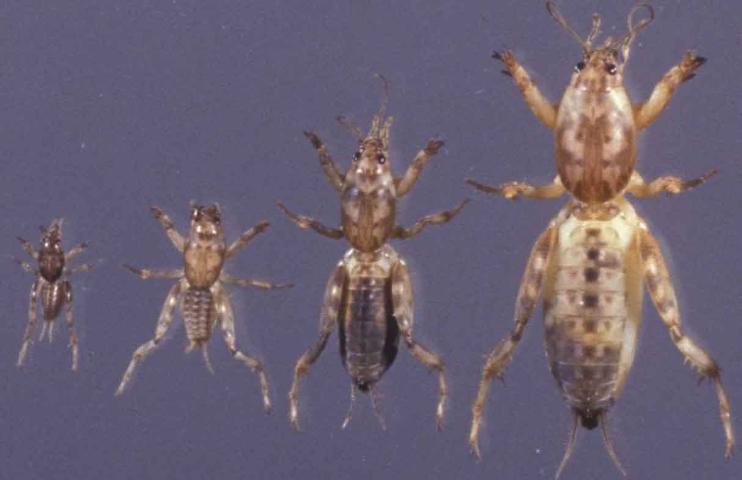
by Larry Williams | Jun 25, 2019
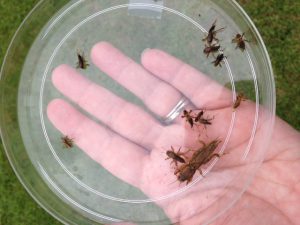
Adult and nymphs of mole crickets. Photo: Julie McConnell, UF/IFAS
The best time to treat for mole crickets is during June through July. But don’t treat at all if mole crickets have not been positively found and identified in the affected lawn areas.
Don’t worry about the adults that are seen flying around lights in the evenings or about the mole crickets found dead in swimming pools this time of year. They are in a mating phase and are doing very little to no damage to lawns during late winter and spring.
We can take advantage of the fact that there’s only one generation per year in North Florida. The eggs will have all hatched by mid to late June. At that time, you’re dealing with young mole crickets that can’t fly and that are much more susceptible to the insecticides designed to kill them. Mole crickets spend winter as adults in the soil. In late February and March, adults emerge and begin mating. Shortly after mating, males die and females fly to suitable areas for egg laying. Mated females deposit eggs in tunnels. After depositing her eggs the female dies. Attempting to control adult mole crickets during this mating period a waste of time, money and product. Plus, adult mole crickets are difficult to control and can easily fly out of treated areas.
You can easily determine if mole crickets are the cause for your lawn problem by flushing them out with a soap and water mixture.
Mix 1½ ounces of a lemon scented liquid dish-washing soap in two gallons of water in a sprinkling can or bucket. Pour the soapy water over an area approximately four square feet and count the number of mole crickets that emerge. It only takes several minutes for mole crickets to crawl to the surface after the soap treatment if they are present. Repeat the process around the yard where you suspect mole cricket problems. If you flush an average of two to four crickets are flushed out per site, control may be needed.
There are a number of insecticides on the market to control mole crickets. But before using any product, first identify the problem as mole cricket damage by using the soap flush technique. Then choose a lawn insecticide that lists mole crickets on its label. And finally read the label carefully for use directions, application techniques, irrigation requirements and precautions.
For more information on mole crickets, including recommended insecticides and other non-chemical control options, contact the UF/IFAS Extension Office in your County or access the following links.
Insect Pest Management on Turfgrass
Shortwinged Molecricket
Mole Cricket IPM Guide for Florida

by Larry Williams | Apr 20, 2015
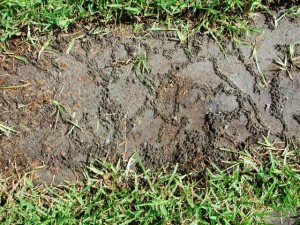
Mole cricket tunnels. Credit: N. Leppla, UF/IFAS
Many people treat their lawn with an insecticide when they see mole crickets in the spring or at the first sign of a brown area in their lawn. What they don’t understand is the biology of this pest.
Mole crickets spend the winter as adults in the soil. As temperatures warm in late February and March, adult mole crickets emerge and begin to mate. Male mole crickets construct a chamber in the soil and chirp to attract female crickets. Attracted females fly to the males. After mating, males die and females fly to a suitable area for egg laying. Mated females begin tunneling and laying eggs in the tunnels. They lay about four clutches of eggs in different areas, averaging 35 eggs per clutch. Female crickets die shortly after laying their eggs.
Use of insecticides during early spring is not recommended because:
- adult mole crickets are not easily killed
- they cause minimal lawn damage during the mating and egg laying process, and,
- reinfestation from subsequent flights is likely.
The best time to treat for mole crickets is during mid-June through July. This will be when eggs have hatched but before the nymphs (immature mole crickets) are large enough to do much damage. Proper timing of the insecticide application is very important to achieve control.
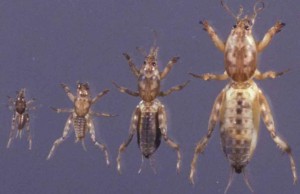
Mole cricket nymphs. Credit: J. Castner, UF/IFAS
If you are not sure if mole crickets are present, you can find out with a soap solution. Mix 1½ fluid ounces of a lemon scented liquid dishwashing soap in two gallons of water in a sprinkling can or bucket. Pour the soapy water over an area approximately four square feet and count the number of mole crickets that emerge. If they are present, it only takes several minutes for mole crickets to crawl to the surface after the soap treatment. Repeat the process around the yard where you suspect mole cricket problems. If you flush an average of two to four crickets per site, treat the lawn with an insecticide. Follow up with spot treatments if any crickets escape the first insecticide treatment. But don’t treat at all if there is no evidence of mole cricket activity.
There are a number of products for mole cricket control in home lawns. Look for insecticides that contain the following active ingredients: bifenthrin, carbaryl, cyfluthrin, deltamethrin, imidacloprid , lambda-cyhalothrin or permethrin.
Before using any product for mole cricket control first identify the problem as mole cricket damage by using the soap flush technique. Then choose an insecticide that lists mole crickets on its label. And finally, read the container carefully for use directions, application techniques, irrigation requirements and precautions.











